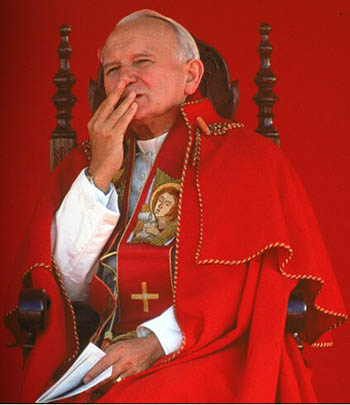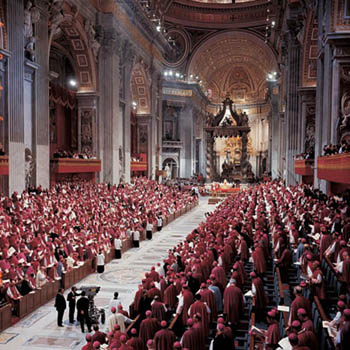 |
Church - State Relations
JPII & Dignitatis Humanae - I
John Paul II’s Hermeneutic Criteria
Julio Alvear, Ph.D.
This study is a summary taken from a larger work based on research from 700 documents of John Paul II regarding religious liberty that embraces his whole pontificate. The question of the degree of authority of each of the documents – encyclicals, apostolic letters, allocutions around the world, general audiences, etc. – is not taken into account, because what interests us here is only to know the doctrinal system drawn from all the sources.
From this perspective, we can affirm that John Paul II left a complete hermeneutics on the conciliar Declaration Dignitatis humanae (DH). Based on what was already started by Paul VI, he developed what we can call an authentic post-conciliar magisterium on religious liberty, an enormous doctrinal body that allows us to resolve if not all, at least a substantial part of the controversies surrounding the interpretation of DH that have arisen through the course of the last 40 years.
Such controversies rose neither from the goodwill of one side nor the bad of the other, but rather from the fact that the conciliar text itself contains ambiguous formulae that left the door open to different and even opposite readings.
It is useful to note that John Paul II does not limit himself to citing or recalling in passing central passages of DH, explaining their content or clarifying their scope of applications. Rather, he makes a veritable magisterial development, extending the right of religious liberty to foundations, objects and ends not explicitly formulated in that conciliar document.
Has John Paul II developed a personal doctrine on religious liberty, unconnected to the doctrine of DH?: Or did he deliberately intend to explain what was implicit or hidden in the conciliar texts, linking the letter of the document with the “dynamics” of its spirit, thus emphasizing the co-relation between DH and the ensemble of Vatican II as a whole?
It is this last hypothesis that we hold, because in the opposite case we would be led to suppose that John Paul II would not have been in accord with the work of the Council, which, besides being absurd, would contradict his dearest and most obvious objective.
Criteria to understand the Council
Further, John Paul II himself has indicated the criteria that should orient “the dynamics of the teaching” of Vatican II, (1) which are neither limited to a simple literal assessment of the documents, already quite delicate, nor to a static doctrine. It is impossible to fully elaborate this matter here, but we can rapidly list the criteria used by John Paul II, citing them below:

The criteria of John Paul II to analyze Vatican II
 |
1. “This universal Council is a kind of milestone, an event of the utmost importance in the two thousand year history of the Church and, consequently, in the religious and cultural history of the world.” (2)
2. “The Council must be understood in its continuity with the great tradition of the Church, but at the same time we must receive from the doctrine of the Council a light for the Church of today,” (3) and “in accordance with the demands placed on it by the ‘signs of the times.’” (4)
3. “Just as the Council is not limited to the documents alone, neither is it completed by the applications that were devised in the years of its unfolding.” (5) “A new period opens to our eyes. It is the time of the profound unfolding of the conciliar teachings.” (6)
4. “It is necessary, above all, that our minds be in harmony with the Council so that putting into practice those things that were ordered by it, those things hidden in it – or as it is generally said, implicit in it – may become explicit in the light of the actual experimences and demands of new circumstances.” (7)
5. “It is urgent that the fertile seeds which the Fathers of the Ecumenical Council, inspired by the Word of God, sowed in the good ground (Mt 13:8-23) – that is, the important teachings and pastoral deliberations – should sprout in a dynamic and living style.” (8)
6. “The Council … has defined what the mission of the Church is in this actual stage of History.” We must “concentrate all our efforts on the correct - that is to say, authentic - interpretation of the conciliar magisterium as the indispensable foundation for the subsequent self-realization of the Church.” (9)
7. “The theological interpretation of the conciliar doctrine must take into consideration all the documents in themselves and in their relation with the others, which will allow the exposition of the proposals of the Council in their complete meaning and full context. Special attention must be given to the four major Constitutions, keys to the interpretation of the other Decrees and Declarations.” (10)
8. The Church has traced the principles of her action in the fundamental Declaration Dignitatis humanae of Vatican Council II, and it is to this document that we must always refer for a true and lasting spiritual peace within nations.” (11)
From these criteria, John-Paul II bases his reading of DH, which revolves, in our opinion, around the following three theses:
a. The right to religious freedom has a broader aim that what can be inferred from a traditional reading of DH.(12) It is a right that has a negative content, but above all a positive one.
b. The right to religious liberty is ultimately founded on the dignity of the human person, as DH affirms, but it is founded immediately on the humanist values shared by all religions and all cultures: fraternity, solidarity, civil peace and pan-ecumenical union. These are the values that entitle one to the right to religious freedom today.
c. One must renounce, at least in practice and probably also in doctrine, the juridical conception traditionally adopted in the social teaching of the Church that implied a necessary connection between the public law of the States and natural law, which in the historical order is inseparable from the law of Christ.
We are interested here in the first thesis, that is to say, in the passing from a negative conception of the right to religious liberty to a positive conception of it. That is what we will examine in the next article.
1. John Paul II employs the term in his Closing Speech of the International Congress on the Application of Vatican Council II, Sono molto lieto (February 27, 2000, no. 5). The cited texts follow the French version given by the Vatican Information Service.
2. First radiomessage of John Paul II Urbi et Orbi – Unum solummodo verbum of October 17, 1978; in the same sense, see the Apostolic Letter Ecclesia Dei in the form of a motu proprio, of July 2, 1988, n. 5b.
3. Final speech of the Roman Synod Exeunte coetu secundo, December 7, 1985, n. 5; in the same sense, see the Apostolic Letter Ecclesia Dei in the form of a motu proprio, of July 2, 1988, n. 5b.
4. Speech on events of France, Dieu soit loué, June 1980.
5. Unum solummodo verbum.
6. Sono molto lieto, n. 9
7. Unum solummodo verbum.
8. Ibid. 9. Dieu soit loué.
10. Exeunte coetu secundo.
11. Ci ritroviano, speech to the sacred College of December 22, 1980, n. 8.
12. In his speech Dieu soit loué, n. 2, John Paull calls for abandoning the traditionalism that calls itself “integrist.” He describes the “integrists” as those “who harden themselves by closing in on a given period of the Church in a stage of theological liturgical expression taken as absolute, without sufficiently penetrating the deeper meaning or considering its whole history and legitimate development, fearing new issues.”
Continued

Article first published in the magazine Catholica, Paris, Spring 2009
Posted October 24, 2012

Related Topics of Interest
 Is the Council under Suspicion of Heresy? Is the Council under Suspicion of Heresy?
 The Growing Rejection of Vatican II The Growing Rejection of Vatican II
 Vatican II: Heretical or Ambiguous? Vatican II: Heretical or Ambiguous?
 Vatican II Revisited Vatican II Revisited
 Pope Wojtyla Rewarded by Freemasonry Pope Wojtyla Rewarded by Freemasonry
 The Perplexing Pontificate of Pope John Paul II The Perplexing Pontificate of Pope John Paul II
 A Rabbi Lectures the Church of Christ A Rabbi Lectures the Church of Christ
 Consequences of Vatican II Consequences of Vatican II

Related Works of Interest
|
|
Church-State | Cultural |
Home | Books | CDs
| Search | Contact Us
| Donate

© 2002- Tradition in Action, Inc. All Rights Reserved
|
 |

|